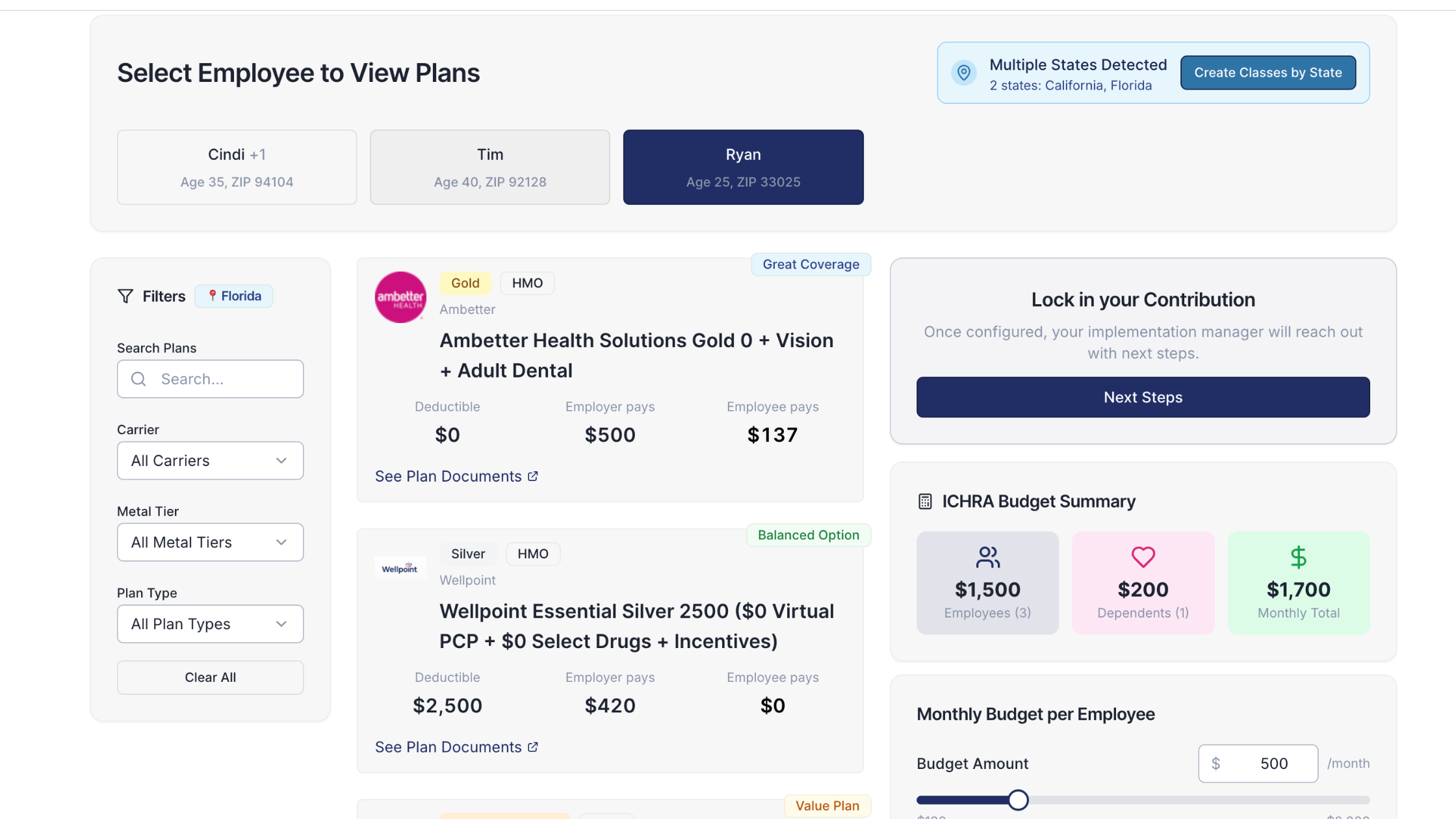How to Reduce Health Insurance Costs by 30% with ICHRA

Managing the rising costs of healthcare is a major challenge for businesses of all sizes. As an employer, you want to provide valuable benefits to attract and retain talent, but traditional group health insurance plans can be unpredictable and expensive. While savings can vary based on your company's specific circumstances, this guide will show you how to potentially reduce health insurance costs by up to 30% using an innovative solution called an Individual Coverage Health Reimbursement Arrangement (ICHRA).
Understanding ICHRA: A Modern Solution for Health Insurance
ICHRA represents a fundamental shift in how employers can offer health benefits. Instead of a one-size-fits-all group plan, it provides a flexible and budget-friendly alternative that empowers employees with choice. This model helps businesses manage their finances while still offering competitive health benefits.
What is ICHRA and How Does It Work?
An Individual Coverage Health Reimbursement Arrangement (ICHRA) is a type of health benefit that allows employers to provide a tax-free monthly allowance to their employees. Employees can then use this allowance to purchase individual insurance plans that best fit their personal health needs and budget. The process is straightforward: the employer sets a contribution amount, and employees shop for a plan on the individual market or a private exchange.
Once an employee purchases a qualified health plan, they can submit proof of their premium payments for reimbursement from the allowance provided by their employer. This model moves the employer out of the role of choosing the insurance plan and into the role of a financial contributor. It’s a defined contribution model, similar to a 401(k), but for health insurance. This approach simplifies administration for the employer and gives employees the freedom to select coverage that works for them and their families.
The Key Benefits of Implementing ICHRA
ICHRAs offer numerous advantages for both employers and employees, making them an attractive option for businesses looking to cut healthcare expenses and enhance their benefits package.
- Budget Control for Employers: With ICHRA, employers have complete control over their health benefits budget. You decide the exact allowance amount for your employees, eliminating the risk of unexpected premium hikes associated with traditional group plans. This predictability makes financial planning much simpler.
- Flexibility and Customization: ICHRAs are highly flexible. Businesses can offer different allowance amounts to different classes of employees, such as full-time vs. part-time or salaried vs. hourly workers. This allows you to tailor your benefits strategy to your company's structure and budget.
- Employee Choice and Personalization: Employees are no longer locked into a single group plan that may not meet their needs. With ICHRA, they can choose any qualified individual health plan from the open market. This allows them to select a plan with their preferred doctors, coverage levels, and premium costs.
- Simplified Administration: Managing ICHRA is often less complex than administering a traditional group health plan. There are no plan renewals to negotiate or participation rates to meet. The employer's primary responsibility is to set the allowance and ensure compliant reimbursement.
Comparing ICHRA to Traditional Group Health Insurance
Understanding the differences between ICHRA and a traditional group health plan is key to understanding why so many businesses are making the switch. While both provide a way to offer health benefits, their structure, cost, and flexibility are very different.
How ICHRA Can Lead to Significant Cost Savings
The claim of saving up to 30% on health insurance is an achievable goal for many businesses that strategically implement ICHRA, but it is not a guarantee. Actual savings depend on variables like your location, how you structure employee classes, and the costs of plans on the local individual market. The savings come from moving away from the rigid and often inflated costs of group insurance to a more controlled and efficient reimbursement model.
Tailoring ICHRA to Fit Your Business Needs
One of the most powerful features of ICHRA is the ability to customize it. You are not required to offer the same benefit to every single employee. The IRS allows employers to create different "classes" of employees and offer different allowance amounts to each class. This is a key strategy for optimizing your benefits spending. For example, you could set one allowance amount for full-time employees in one state and a different amount for part-time employees or those in another geographic location. This ensures you are providing a competitive benefit where it matters most without overspending across the board. This targeted approach allows small businesses in particular to offer health insurance for small business owners and their teams in a way that is financially sustainable.
Utilizing Reimbursement Strategies for Maximum Savings
With ICHRA, your company only pays for the funds that employees actually use. If an employee finds a plan that costs less than their monthly allowance, the employer only reimburses the actual premium cost. The unused funds remain with the company. This is a major departure from traditional group plans, where the employer pays a fixed premium for every enrolled employee, regardless of how much they use their health services. This "pay for what's used" model of a health reimbursement arrangement is a core driver of cost savings and helps to lower health insurance premiums for the company over time.
Understanding ICHRA Affordability Rules
To ensure ICHRA is a valid and compliant benefit, employers must follow IRS affordability rules, especially if they are an Applicable Large Employer (ALE) with 50 or more full-time equivalent employees. ICHRA is considered "affordable" if the employee's required contribution for the lowest-cost silver plan on the individual exchange does not exceed a certain percentage of their household income. This percentage is set annually by the IRS. For 2025, the threshold is 9.02%, and for 2026 it will be 9.96%. This rule is in place to ensure that the benefit offered is meaningful and that employees are not priced out of coverage. By carefully setting allowance amounts based on local plan costs, employers can meet this requirement while still controlling their overall budget.
Calculating Your Health Insurance Costs with ICHRA
How to Determine ICHRA Affordability
Calculating affordability is a critical step for Applicable Large Employers (ALEs) to avoid potential penalties. The calculation centers on the cost of a specific type of health plan available to the employee.
First, you must identify the monthly premium for the lowest-cost silver plan available to the employee on the individual marketplace based on their location. This information can be found on government healthcare websites. Next, subtract your monthly ICHRA allowance from this premium. The remaining amount is the employee's contribution. Finally, this contribution must be less than 9.02% (for 2025) of the employee's monthly household income. Since you may not know their total household income, the IRS allows employers to use safe harbors, such as using the employee's W-2 wages, to perform this calculation.
Examples of Potential Cost Savings from ICHRA Implementation
To illustrate the potential savings, let’s consider a small business with 15 employees. A traditional group plan might quote them a premium of $600 per employee per month, totaling $9,000 per month or $108,000 annually. This cost could easily increase by 10-15% the following year.
With ICHRA, the employer could offer a monthly allowance of $450 per employee. The total maximum exposure for the employer is now $6,750 per month or $81,000 annually. This immediately represents a 25% reduction in potential costs compared to the group plan. If some employees choose plans that cost less than $450 or are covered under a spouse's plan and waive the benefit, the employer's actual spending will be even lower. This combination of controlled allowances and reimbursing only for actual expenses means savings of 30% or more can become a reality for some businesses.
Common Questions About ICHRA and Health Insurance Savings
When considering a new approach to health benefits, it's natural for questions to arise. Many employers want to know how these changes will directly impact their budget and their employees' ability to secure coverage.
How Can I Reduce the Amount I Pay for Health Insurance Premiums?
For an employer, ICHRA is a direct way to manage and potentially reduce the amount you pay toward health benefits. By setting a fixed allowance, you cap your financial liability each month. For employees, ICHRA empowers them to find plans that fit their budget. If their allowance covers the full premium of a plan they choose, their out-of-pocket premium cost is zero. This flexibility is a powerful way for everyone to save money on health insurance.
What Percentage of Pay Should Go to Health Insurance?
There isn't a single rule for what percentage of pay should go toward health insurance. However, the IRS uses a specific benchmark for affordability. As mentioned, an employer's ICHRA offer is considered affordable if the employee's portion of the premium for the lowest-cost silver plan is no more than 9.02% of their household income in 2025. This provides a guideline for employers when setting their allowance amounts to ensure the benefit is fair and compliant.
Can We Reduce the Health Insurance Premium?
Yes, ICHRA is a tool designed specifically to help businesses control and potentially reduce what they spend on health benefits. Unlike traditional group plans where you negotiate premiums with an insurer, ICHRA allows you to set the budget. This gives you the power to design a benefits plan that aligns with your financial goals, helping you cut healthcare expenses without sacrificing the quality of healthcare offered to your employees.
Final Thoughts on ICHRA and Health Insurance Savings
ICHRA offers a modern, sustainable path for businesses to provide excellent health benefits. It puts employers back in control of their budgets and gives employees the freedom to choose coverage that truly works for them. For any business owner looking for a way to escape the cycle of rising group insurance costs, ICHRA is a compelling solution.
Key Takeaways for Employers Considering ICHRA
- ICHRAs provide predictable, fixed costs for health benefits.
- They satisfy the employer mandate for Applicable Large Employers (ALEs).
- They give employees the freedom to choose their own health plan.
- Unused allowance funds stay with the employer, creating additional savings.
- Administration is simplified compared to managing a group plan.
Next Steps to Implement ICHRA in Your Business
Start by evaluating your current health benefits budget and talking to your team about their needs. Then, partner with a benefits expert who can help you design a compliant ICHRA plan, set appropriate allowance amounts, and manage the administration. Making this change can help reduce health insurance costs and provide a more valued benefit to your employees.
Navigating the transition to an ICHRA can seem complex, but you do not have to do it alone. Venteur specializes in helping businesses of all sizes design and implement customized ICHRA plans that align with their financial goals and company culture.
From setting compliant allowance amounts and managing employee classes to providing a user-friendly platform for reimbursements, Venteur handles the administrative burden so you can focus on what matters most, running your business. Partnering with an expert like Venteur ensures a smooth rollout and helps both your company and your employees maximize the value of your new health benefits.
You got questions, we got answers!
We're here to help you make informed decisions on health insurance for you and your family. Check out our FAQs or contact us if you have any additional questions.
No, ICHRA is not a group health plan. It is a health reimbursement arrangement that allows employees to buy their own individual health insurance policies, which they own and can take with them if they leave the company.
There is no legal minimum contribution amount for ICHRA. Employers have the flexibility to set any allowance amount they choose, as long as it is offered fairly to all employees within a specific class.
No, to receive ICHRA reimbursements, an employee must be enrolled in their own qualifying individual health insurance plan. They cannot be on a spouse's group plan and also receive ICHRA funds for premiums.
Employers have two main options for handling unused ICHRA funds at the end of the plan year.
- Choose to have the funds returned to the company. This is the most common approach and contributes to overall cost savings.
- Allow a portion or all of the unused funds to roll over for the employee to use in the next plan year.
To be eligible for reimbursement, employees must purchase a qualified individual health insurance plan. These plans typically include:
- Major medical plans purchased on the state or federal healthcare exchange (Marketplace).
- Major medical plans purchased directly from an insurance carrier (off-exchange).
- Medicare Parts A, B, C, or D, for eligible employees.
Explore more related content
What is Venteur
Explore the best human-first Health Insurance platform
Simple, personalized health benefits
Sign up in minutes, define your contribution, and let your employees choose the health plan that works right for them
Integrations to make everything run smoothly
We'll connect with your payroll and finance systems to make deductions and premium payments seamless
Easy onboarding and off-boarding
In just a few clicks, add your roster and make updates on the fly. We'll handle it from there.
Venteur Certified Brokers to help your employees pick the right plan
Our trusted brokers ensure the best outcomes for employees and employers by unlocking health savings and providing unrivaled plan options.
AI-powered plan recommendations to give you confidence while you shop
Backed by 30 years of healthcare data, Venteur’s AI helps employees compare and choose the best plan for their unique situation.
Compliance and reporting because no-duh!
Venteur manages plan administration, reporting, and compliance so you can focus on growing your business.


